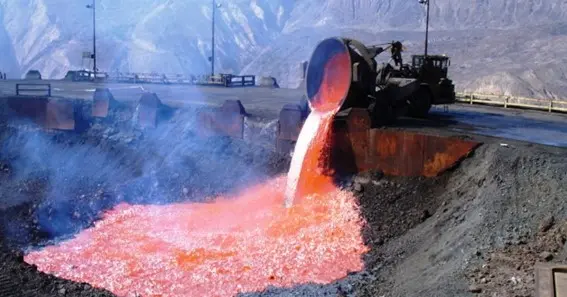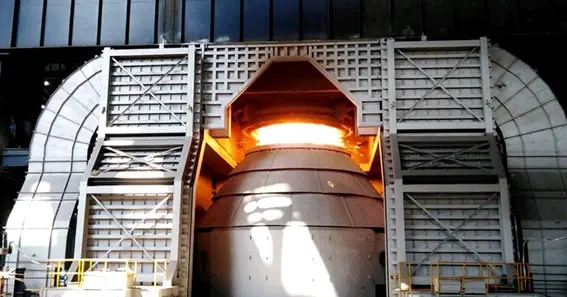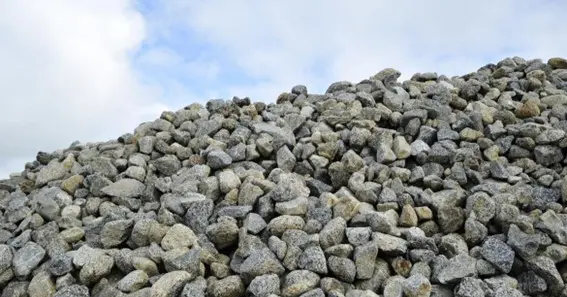What is slag? Slag is a non-metallic by-product formed during the smelting or refining of ores and metals. Slag is an essential metal manufacturing byproduct from smelting ores and recovered metals. As a minor substance, slag gets less attention than ore metals. This is important since it influences numerous industrial processes and aids environmental management. To comprehend slag, you must examine its composition, types, and uses. It would help if you comprehended this to understand its effects on business and the world. This article describes what is slag and explore more about it.
What Is Slag?
Slag is a non-metallic by-product formed during the smelting or refining of ores and metals. Slag is a non-metal byproduct of smelting metals and ores. Chemical methods during metal extraction remove contaminants to produce pure metals. Slag helps separate useful and undesirable metals during metal cleaning. Slag is mostly metal oxides and silicon dioxide. The composition depends on the ore and melting procedure. Slags from iron ore heating differ from those from aluminum or copper ores. This composition change affects slag’s properties and utilization. Different ore and melting methods affect slag quality. Slag’s composition can vary, yielding several types with differing properties. The principal varieties are ferrous, ferroalloy, and non-ferrous/base metal slags. Each group uses a different metal and melting method. Iron and steel production produces ferrous slags, which are made in blast and simple oxygen furnaces. Iron and other elements are used to make steel from ferroalloy slags.
Information Essential To Understanding Slag

Slag must be defined to comprehend its role in industrial processes and environmental management. It involves recognizing its parts, types, and uses. Learn about what is slag to appreciate its importance.
Slag Composition
Slag is mostly metal oxides and silicon dioxide. Common metal oxides include iron, calcium, magnesium, and aluminum. Silicon dioxide dominates the slag’s non-metallic portion. Varied rocks and smelting procedures yield varied slag. Melting iron ore in a blast furnace produces iron oxide slag, while melting copper produces copper and sulfur compounds.
Different Slags
As we already discuss what is slag, now here we discuss about different slags:
- Iron slag: Iron and steel production wastes this slag. Iron blast furnaces produce ferrous slag, and basic oxygen furnaces produce slag when making steel.
- Ferroalloy slag: Slag from ferroalloy production contains alloying components that strengthen steel. Ferroalloy slags contain manganese, chromium, and silicon.
- Non-ferrous slag: Slag remains after mining non-ferrous metals like copper, nickel, zinc, and iron. Many companies use non-ferrous slags for road construction and cement production.
Production Methods
Different metalworking procedures create slag with different qualities. Common methods of making include:
- Blasting furnaces: Blast furnaces produce slag when manufacturing iron. Different cooling processes can transform slag into granules or air-cool it.
- Electric arc stoves: These furnaces produce electric arc furnace slag for steelmaking. Builders and cement makers use this slag.
- Simple Oxygen Furnaces: Basic oxygen furnaces create slag when manufacturing steel. The slag’s high calcium oxide content makes it valuable in many circumstances.
Blast Furnace Slag
Blast furnace slag is an iron-making byproduct. Mixing iron ore, coke, and blast furnace fluxes creates chemical processes. This slag can be air-cooled or powdered.
- Air-Cooled Slag: Air-cooled blast furnace slag can cool slowly outside. People create a roadbase with this slag.
- Small-sized slag: Making granulated slag requires swiftly cooling melted slag with water. It is glassy and used to create cement and other products.
Air-Cooled Vs. Granulated Slag
Slag cooling alters its properties and uses:
- Air-Cooled Slag: Slag cools slowly in the open air, forming a rough, crystallized structure. Its stability and durability make it popular in construction and road building.
- Small-sized slag: Quickly cooling anything with water creates a fine, glossy material. Granulated slag strengthens and prolongs concrete.
Beginners’ Oxygen Furnace Slag

Simple oxygen furnaces create slag when making steel. Due to its high calcium oxide content, this slag helps build roads and homes. The oxygen furnace makes steel by blowing oxygen through molten iron. Slag cleans steel.
Electric Arc Furnace Slag
Steelmaking in an electric arc furnace produces slag, which is used for building materials due to its characteristics. Electric arc furnaces melt scrap steel using electric arcs. Building roads and manufacturing cement from slag is common.
Environmental Impacts
Different means of disposing of slag can affect the planet. Slag management is crucial to reducing environmental hazards. Dealing with slags containing heavy metals or other harmful chemicals requires caution. Recycling slag reduces waste and protects natural resources, benefiting the environment.
Usage And Recycling
Here we discuss what is slag uses:
- Structure: Using slag, builders construct road bases, concrete aggregates, and asphalt.
- Cement Making: Granulated slag strengthens and prolongs concrete.
- Going green: Recycling slag reduces waste and preserves resources. Its shapes and sizes can be varied for different industries.
Conclusion
Slag is frequently considered waste; however, it is vital to metalworking and other industries. Its composition and kind determine its properties and functions, making it a versatile industrial material. By understanding slag types and production, industries can maximize their use and aid the environment. Recycling and treating slag efficiently saves resources and reduces environmental damage, making it crucial in modern industry. In above we discuss what is slag and explore more about it.
FAQ
Where Does Trash Come From?
Slag is primarily made of metal oxides and silicon dioxide. It develops from smelted or refined metals and ores.
What Types Of Slag Are There?
Slag might be ferrous, ferroalloy, or non-ferrous/base metal for manufacturing and application.
What’s The Difference Between Air-Cooled And Powdered Slag?
Cooling granulated slag in water modifies its properties and uses, while air-cooled slag cools slowly.
What Is The Effect Of Waste On The Community?
Different means of disposing of slag can affect the planet. Effective management reduces global hazards.
What Are Some Popular Slag Uses?
Construction, roadbuilding, and cement use slag. Recycling slag reduces waste and conserves resources.
Sources:
https://en.wikipedia.org/wiki/Slag
https://www.toppr.com/ask/question/what-is-slag-explain-with-example










